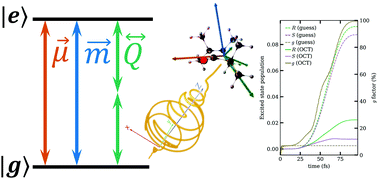Increasing ion yield circular dichroism in femtosecond photoionisation using optimal control theory
Abstract
We investigate how optimal control theory can be used to improve Circular Dichroism (CD) signals for the A-band of fenchone measured via the photoionization yield upon further excitation. These transitions are electric dipole forbidden to first order, which translates into low population transfer to the excited state but allows for a clearer interplay between electric and magnetic transition dipole moments, which are of the same order of magnitude. Using a model including the electronic ground and excited A state as well as all permanent and transition multipole moments up to the electric quadrupole, we find that the absolute CD signal of randomly oriented molecules can be increased by a factor of 2.5 when using shaped laser pulses, with the anisotropy parameter g increasing from 0.06 to 1. We find that this effect is caused by the interference between the excitation pathways prompted by the different multipole moments of the molecule.

- This article is part of the themed collection: Festschrift Ivan Powis: Advances in Molecular Photoelectron Spectroscopy: Fundamentals & Application


 Please wait while we load your content...
Please wait while we load your content...